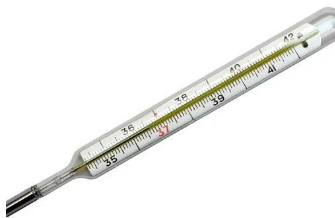Celsius Thermometer: Water’s freezing and boiling points are 0° and 100° respectively on the Celsius scale. As a result of the 100-degree interval between the defined points, the Celsius scale was invented by the Swedish astronomer Anders Celsius in 1742. To convert a Fahrenheit (°F) temperature into a Celsius (°C) value, use the following formula:
°C = 5/9(°F − 32).

Construction
There are three main components of the Celsius thermometer: a transparent thick glass tube, a capillary tube closed from one end, and a mercury bulb filled with mercury attached to the other end.
Explanation
Celsius thermometers have no constriction above the mercury bulb, the scale goes from zero degrees Celsius to 100 degrees Celsius, and each degree is represented by one part.
A Celsius thermometer can reach a temperature of 200 degrees Celsius in some types. The lower fixed point on a Celsius thermometer is 0 degrees Celsius, the melting point of water or the freezing point of ice, and the upper fixed point is 100 degrees Celsius, the boiling point of water.
A thermometer may display two scales, one representing the Celsius scale (°C) and the other representing the Fahrenheit scale (°F).
0°C = 32°F
100°C = 212°F
Why mercury is preferred in making thermometers?
- It is a good conductor of heat and can be seen through the thermometer glass, so mercury is used in thermometers.
- The capillary tube wall does not adhere to mercury, as it is an expanding material that expands regularly. This makes mercury an accurate estimation.
- Since it remains liquid between (−39°C) and (357°C), it can measure a wide temperature range.
- Capillary tubes do not stick to their walls, so it returns to the bulb easily.
A thermometer might have two scaling systems, one for Fahrenheit and another for Celsius (°C).
How to Read a Celsius Thermometer?
Get to know how the Celsius temperature scale works. Under one standard atmosphere of air pressure, the Celsius scale is defined by the temperatures at which water freezes and boils. Water has a zero (zero) freezing point and a hundred (one hundred) boiling point. Every 100 degrees or parts of the temperature interval between are equal.
Temperature scales in Fahrenheit and Celsius should be understood. A water’s freezing point is 32 degrees Fahrenheit, and its boiling point is 212 degrees Fahrenheit. Therefore, 212 minus 32 = 180 degrees on the Fahrenheit scale. There are 1.80 Fahrenheit degrees for every Celsius degree. A Fahrenheit degree is equal to 5/9 of a Celsius degree.
Why Celsius Thermometer is Important (Use):
The Celsius thermometer, which measures temperature using the Celsius (or centigrade) scale, is important for several reasons:
Universal Standard: Celsius is widely adopted as the standard temperature scale in many countries around the world, particularly in scientific and international contexts. It provides a common reference point for temperature measurement, facilitating communication and understanding across different regions and disciplines.
Ease of Use: The Celsius scale is based on the freezing and boiling points of water, with 0°C representing the freezing point and 100°C representing the boiling point at standard atmospheric pressure. This makes it intuitive and easy to understand for everyday temperature measurements, as it corresponds directly to familiar temperature ranges.
Scientific Applications: Celsius is commonly used in scientific research, experimentation, and data analysis across various fields, including physics, chemistry, meteorology, and environmental science. It allows scientists to accurately measure and compare temperatures in experiments, monitor environmental conditions, and analyze climate patterns.
Weather Forecasting: Celsius is the primary temperature scale used in weather forecasting and meteorology. By using Celsius, meteorologists can provide accurate and consistent temperature predictions to the public, helping individuals and organizations make informed decisions about their daily activities, travel plans, and safety precautions.
Health and Safety: Celsius is also used in healthcare settings for monitoring body temperature, assessing fever, and determining appropriate medical treatments. It provides a standardized method for healthcare professionals to measure and interpret temperature readings, aiding in the diagnosis and management of various medical conditions.
